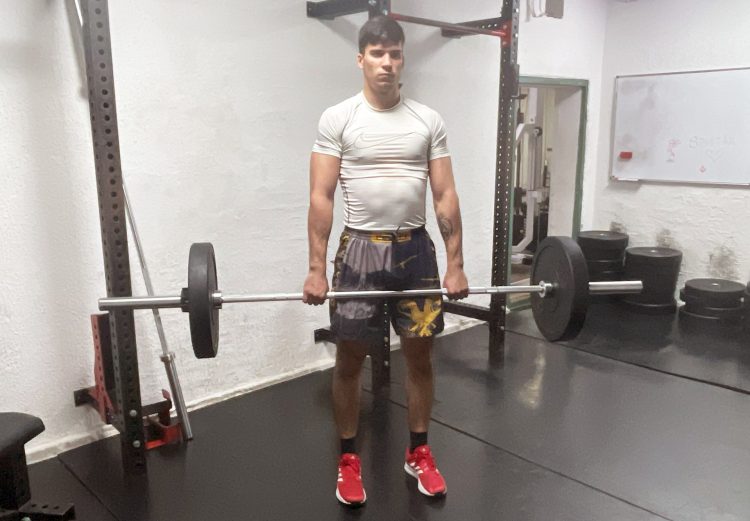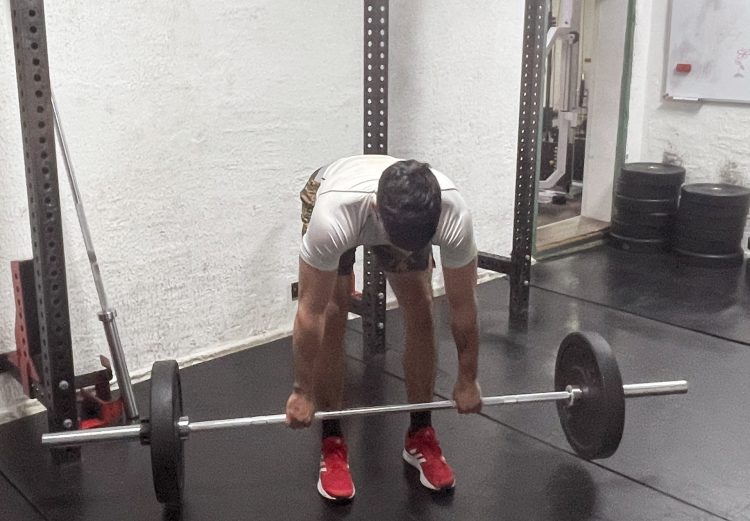Dorian Yates’s journey is a testament to the athlete’s duality: the relentless pursuit of victory and personal growth within the sport and the importance of life after competition.
Even though Yates is now retired, he developed several exercise variations to maximize muscle growth and strength.
Dorian believed you could get much more from traditional deadlifts with a couple of tweaks — movement mechanics and strategically structuring workouts, particularly the exercise order.
How To Perform Dorian Deadlifts
Here is a step-by-step on how to perform this exercise:
Step One — Assume the Starting Position
Load a barbell on the floor with an appropriate weight and stand in front of it with a hip-width stance. Bend over and grab the barbell with a wider-than-shoulders-width overhand (pronated) grip.
Level Up Your Fitness: Join our 💪 strong community in Fitness Volt Newsletter. Get daily inspiration, expert-backed workouts, nutrition tips, the latest in strength sports, and the support you need to reach your goals. Subscribe for free!
Pro Tip: Rack the barbell at hip height on a squat rack to save energy on the lift-off.
Step Two — Lift the Barbell
With your spine neutral, core braced, and knees slightly bent, lift the barbell off the floor by hinging at the hips and performing a triple extension.
Engage your glutes and hamstrings as you stand up fully, and keep the barbell close to your body to improve leverage and reduce stress on your lower back.
Pro Tip: In the starting position, your shoulders should be over the bar and your chest proud. This helps maintain balance and power throughout the movement. To stabilize your upper body and prevent unnecessary swaying, engage your lats by imagining you’re squeezing oranges in your armpits.
Step Three — Lower the Barbell
From the standing position, lower the barbell toward the floor by hinging at the hips and slightly bending your knees. Stop a few inches before the barbell touches the floor.
Pro Tip: Spend three seconds on the eccentric phase to increase the TUT and promote muscle hypertrophy.
Step Four — Initiate Triple Extension
Return the barbell to the starting position by extending your ankles, knees, and hips simultaneously. Pause briefly in the fully shortened position. Then, proceed with the following repetition.
Pro Tip: Perform the concentric phase as quickly as possible to ensure maximum fast-twitch fiber recruitment.
Dorian Yates’s Deadlift Principles and Rationale
Yates explained his deadlift philosophy for back growth. Here are the crucial principles Dorian emphasizes to make the most out of the deadlift:
Perform Deadlifts Last on a Back Day
Considering general programming guidelines, placing deadlifts last in your workout isn’t the best option. Why? Deadlifts are a compound exercise that activates multiple large muscle groups and heavily taxes the central nervous system. For optimal performance and injury prevention, it’s crucial to tackle deadlifts when your body is fresh and energized.
However, Yates prefers placing deadlifts last in his workout for one simple reason: He won’t have to lift as heavy to achieve the same muscle fiber stimulation as the target muscles are already fatigued.
He adds that this alone increases the total time your muscles are under “quality” tension, allowing for better posterior chain muscle hypertrophy. (1)
Don’t Touch the Bar To the Floor While Doing the Set
The second principle Yates follows when doing deadlifts is never to touch the barbell to the floor. This ensures that the target muscles are under constant tension.
Level Up Your Fitness: Join our 💪 strong community in Fitness Volt Newsletter. Get daily inspiration, expert-backed workouts, nutrition tips, the latest in strength sports, and the support you need to reach your goals. Subscribe for free!
Also, the tension on your lower back and other posterior chain muscle groups is the highest in the bottom position. This optimizes hamstrings, glutes, and erector spinae stretch, resulting in overall better muscle hypertrophy. (2)
Since you are not lifting anything close to your 1RM (one repetition maximum) and your muscles are already fatigued from the first part of your workout, you can achieve much greater stimulus that results in strength, endurance, and muscle hypertrophy adaptations.
Assume a Hip-Width Or Slightly Wider Stance
Dorian likes to assume a slightly wider-than-hip-width stance during almost all deadlift variations. Why? Going too wide can shift the focus from the posterior chain to the thighs and adductor muscles. Having a slightly narrower stance can help you keep the tension on your hamstrings, glutes, and erector spinae.
Dorian Yates Shares Why Super Heavy Lifting in Bodybuilding Is Too Risky
In a YouTube video, Dorian Yates, six times Mr. Olympia, shares why lifting too heavy poses numerous risks with very little to no rewards:
“I advise people to go a little higher in the repetitions and don’t go beyond failure the last six to eight weeks before the competition. Concentrate on your diet, cardio, and everything like that to get lean. There is definitely a risk, and I saw the stuff that Ronnie was doing, and I thought that’s crazy because there are a lot of risks there, especially doing this powerlifting amounts of weight and no benefit apart from “wow, that looks impressive on camera.” I don’t know if that’s why I got injured, but I think lifting heavy wasn’t wise.”
Dorian Deadlift Muscles Worked
The primary muscles worked during Dorian deadlifts include the gluteus maximus, hamstrings, quadriceps, and erector spinae. The secondary muscles are the trapezius, forearms, latissimus dorsi, abdominals, and obliques.
Dorian Deadlift Variations and Alternatives
Here are the best Dorian deadlift variations and alternatives for your posterior chain:
Romanian Deadlift
The Romanian deadlift is an excellent posterior chain exercise that targets your hamstrings, glutes, and lower back more effectively.
Steps:
- Assume a little wider than hip-width stance in front of the barbell.
- Bend at your hips and grab the barbell with a pronated (overhand) grip just outside shoulder-width.
- With your back neutral and core contracted, lift the barbell off the floor.
- Your body should be in a straight line at the top.
- Keep your knees slightly flexed during the set.
- Lower the barbell toward the floor by bending your hips.
- Lower the barbell until it is at shin level. Go as low as your mobility allows.
- Hold the bottom position for one second and return to the upright position.
Pro Tip: Control the descent and keep the barbell close to your body for maximum tension and safety.
Stiff Leg Deadlift
The stiff leg deadlift mirrors the traditional deadlift in its movement pattern, with the primary distinction being a near-straight leg position throughout the lift.
Steps:
- While maintaining a slight bend in your knees, hinge at the hips and grab a barbell with a shoulder-wide pronated grip.
- Bend your knees slightly and keep them steady throughout the entire movement.
- The majority of movement must come from your hips.
- Lift the barbell off the floor while keeping your back straight and core contracted.
- Hold the top position for one second, then reverse the motion to return the barbell to the floor.
Pro Tip: Move slowly, keep your spine neutral, and pull back up using a controlled, powerful hip extension.
Good Mornings
Good mornings will place a greater emphasis on your lower back than the other deadlift variations listed in this article.
Steps:
- Rack the barbell on the squat rack and load it with appropriate weights.
- Position the barbell on your upper back, unrack it, and take a step back.
- Ensure there is enough space in front of you for the lowering phase of the exercise.
- Stand with your feet slightly wider than hip-width apart, and bend your knees.
- With your core contracted and back straight, bend forward by hinging at the hips.
- Lower the barbell until your torso is almost parallel to the ground.
- Hold the bottom position for one second and reverse the motion to return to the starting position.
Pro Tip: Brace your core and maintain a slight knee flexion throughout the exercise. Keep the movement slow and deliberate to avoid lower back strain.
Wrapping Up
Dorian deadlifts are a fantastic exercise that allows you to holistically target your back musculature. However, this exercise might not be effective for all gymgoers.
This is why you must follow a personalized training program based on your unique goals, needs, and morphology and not blindly follow other lifters’ programs.
In the comments below, let me know your thoughts on Dorian’s deadlift variation and how you incorporate it into your back workout sessions.
References:
- Burd NA, Andrews RJ, West DW, et al. Muscle time under tension during resistance exercise stimulates differential muscle protein sub-fractional synthetic responses in men. J Physiol. 2012;590(2):351-362. doi:10.1113/jphysiol.2011.221200
- Bernárdez-Vázquez R, Raya-González J, Castillo D, Beato M. Resistance Training Variables for Optimization of Muscle Hypertrophy: An Umbrella Review. Front Sports Act Living. 2022;4:949021. Published 2022 Jul 4. doi:10.3389/fspor.2022.949021
Relevant Articles:
- Deadlift Form 101: How to Lift More Weight Safely
- Deadlifting Daily for a Month: Key Insights and Lessons
Interested in measuring your progress? Check out our strength standards for Good Morning, Stiff Leg Deadlift, Deadlift, and more.











